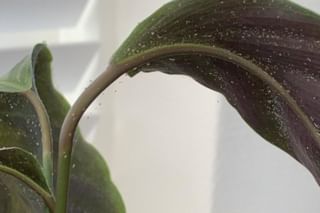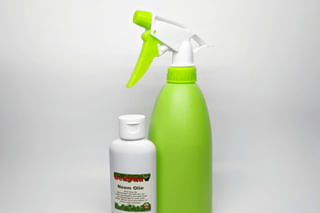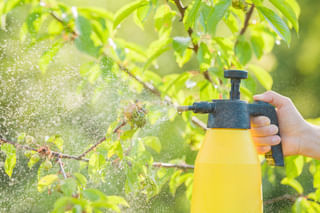How to get rid of spider mites on your houseplants
Discover effective ways to rid your houseplants of spider mites. Learn to identify, treat, and prevent these unwanted visitors with this comprehensive guide. Follow my advice to keep your indoor green friends healthy, flourishing, and free from spider mites forever.

Your houseplants are special and they should be protected from all kinds of pests. You water it properly and take good care of it, but then you find spider mites on your plant and they don't seem to go away. So what do you do to get rid of these pests from your houseplants? In this guide, we'll answer that question and look at what you can do to get rid of the spider mites. We'll also find out how you make sure your plant recovers quickly and doesn't die off.
In this guide, we'll go over the following topics when it comes to spider mites:
Let's dive right in a learn how to deal with spider mites!
What are spider mites?
Spider mites are very small spider-like insects that like to be on the bottom of your plant's leaves. They can cause damage to your plants by poking holes in the plant's leaves and feeding on them. This can cause the plants to slowly dry out, as the spider mites absorb the moisture. Spider mites eat a wide variety of plants, so it's very likely your plants could be on their feeding list.
Identifying spider mites
These tiny creatures are not spiders but belong to the arachnid family, and they can have a massive impact on your plant's health before you even know it.
So, how do you identify spider mites on your plants? Well, the first sign is often a dull or yellowing appearance on the leaves of your plant. Looking closer, you may see small, light-colored dots on the underside of the leaves. These dots could be spider mites in their early stages.
As spider mites grow, they become more visible. They are about the size of a grain of sand and usually have eight legs and a round body that ranges in color from red to green or yellow.
What are the symptoms of a spider mite infestation?

So one of the easiest signs of spider mites is discoloration of the leaves. As the mites feed on the leaves, they leave behind tiny yellow or brown spots that can eventually merge and cause the entire leaf to turn yellow or brown.
Another sign of spider mites is the presence of webbing on the plants. While it can be difficult to see the mites themselves without a magnifying glass, the webbing they produce is usually quite visible. This webbing can cover entire leaves or even entire plants in severe cases.
Plants that are infested with spider mites may also start to look unhealthy overall. They may be stunted in their growth, or they may have curled or twisted leaves. In some cases, the plant may even begin to die back.
Why are spider mites harmful to houseplants?
Spider mites are harmful to your plants because they cause quite a bit of damage to the leaves. You can see these tiny pests with the naked eye, but they are more easily spotted through a magnifying glass as they're usually smaller than 1mm. These pests love dry and hot conditions, which is why they thrive in indoor spaces, greenhouses, and gardens during summer.
Spider mites damage your plants in several ways: loss of plant strength, stunted growth, and yellowing of leaves. At first, they only cause light dots on the leaves (stippling) that turn yellowish or reddish. Over time, the spider mites can cause the leaves to turn brown, and in severe cases, the leaves may eventually fall off.
Spider mites do not discriminate, and they feast on a variety of plants, including vegetables, fruits, flowers, and decorative plants. The main method of controlling spider mites is through early detection and quick action.
What can you do to get rid of spider mites?
There are several things you can do to get rid of spider mites. Some are a little easier than others, but they all require a few treatments. Before you do anything, you should move your infected plant away from your other plants, to make sure the spider mites don't spread to healthy plants. Once you have done this, these are a few simple things you can do to help get rid of the spider mites:
- Use a spray bottle with household soap and water
- Use neem oil
- Use predatory insects to eat the spider mites
- Use insecticidal soap
Let's look at each of these solutions a little more closely.
1. Use a spray bottle with household soap and water
By far, the easiest solution is getting a spray bottle, one that you also use to mist your plants and add a few drops of liquid dish soap to the water. Now, when you spray your plant with this mixture, you'll create a soapy layer on your leaves and this will drown the spider mites. After you've let it sit for a few minutes, you can clean every single leaf with a paper towel or microfiber cloth. This way you're removing the soap from the plant and you're getting rid of any of the spider mites that might still be on the leaves.
This is not a one-time solution, and you might need to repeat this a few weeks in a row. It's best to let the plant rest a week in between treating it this way and the next time. Make sure to spray both the top and bottom of the leaves, as well as the stems.
2. Use neem oil
Neem oil is a vegetable oil that you can buy in most grocery stores. It's an oil that's created by pressing fruits and seeds. Unlike the soap and water solution, this does not drown the spider mites. You can use neem oil as a repellant for spider mites by applying it to the leaves and stems of the infected plant. This will create a hostile environment for the spider mites and they'll get away from the plant.
Like the soap and water solution, this is not a one-time solution and should be repeated until all spider mites are gone. It's best if you do this every few days until you notice the spider mites are gone.
It is important to note that I discourage the use of chemical insecticides as they can harm beneficial insects. It is always best to use natural, organic pest-management solutions whenever possible. However, if the infestation is so large that natural solutions don't seem to have any effect, you can use the chemical solution to get rid of the spider mites.
3. Use predatory insects to eat the spider mites
A last, and also slightly more daring solution, is to use insects to get rid of other insects. It's best to use mites from the Phytoseiulus family, as these prey on spider mites and will eat 2-25 of them, in addition to quite a few eggs, per day. It's an effective way of getting rid of spider mites without really having to do much yourself. However, you are introducing other insects to your plants. This could feel uncomfortable, but people use this method to keep plants in greenhouses pest-free as well.
Other than using mites from the Phytoseiulus family, you can also use insects such as ladybugs or lacewings, which will naturally control the spider mite population.
These predatory insects will get to work quickly and will die once the pests have all been eaten, as there won't be any food left. This could be a great solution if the other two didn't work or if you don't have time to get rid of the pest yourself.
4. Insecticidal soap
Another solution to get rid of spider mites is to use insecticidal soap, which is a non-toxic solution that kills spider mites by suffocating them. Pyrethrin-based sprays can also be effective in getting rid of spider mites. It is important to note that when using any of these treatments, it is important to follow the instructions carefully and apply them regularly until all spider mites are gone.
Remember, prevention is key when it comes to controlling spider mites. Try to keep your plants healthy and well-watered, and avoid overcrowding them. By following these guidelines and watching closely, you can keep your plants healthy and free from spider mite damage.
Recovery
Once the spider mites are gone, your houseplant will be weak from fighting off the pest. Now it's the time to give it the care it needs and help it recover slowly but steadily. If it's in the growing season (spring and summer), it's a great idea to give your plant a little bit of fertilizer, so it can replenish all the nutrients it lost while the pest was there. If it's in the dormancy period (fall/autumn and winter), make sure to give the plant the proper water and light requirements.
Besides watering your plant properly, giving it the sunlight levels it needs, and fertilizing it to help recover, you should also prune any damaged leaves. These damaged leaves make the plant look bad, but more importantly, they still "steal" nutrients from your plant. These damaged leaves won't turn back to their great looks, so by pruning these leaves, you give your plant some energy back to grow stronger and grow new leaves.
Preventing spider mites
So how do you prevent spider mites from coming back? By taking preventive measures! If you want to keep spider mites off your houseplants, prevention is key. Here are some steps you can take to avoid an infestation in the first place:
- Keep your plants healthy: Spider mites prefer plants that are already weak or stressed, so make sure your houseplants are getting the right amount of water, light, and nutrients.
- Provide proper ventilation: Spider mites thrive in warm, stagnant air, so make sure your plants have access to fresh air. You can open a window, use a fan, or even move your plants outside for a few hours each day (only during the summer). Make sure your plants don't sit in cold drafts though.
- Inspect new plants: Before bringing a new plant into your home, inspect it carefully for signs of spider mites or other pests. If you do find any, quarantine the plant until you can treat it.
- Clean your plants regularly: Dust and debris can attract spider mites, so make sure to wipe down your plants' leaves regularly with a damp cloth. This will also help keep your plants looking shiny and healthy.
- Keep the humidity high: Spider mites prefer dry conditions, so using a humidifier or grouping your plants can help keep them away.
By taking these preventive measures, spider mites will think twice about coming back to your plant.
Conclusion
Spider mites are a scary sight and they can be a tough pest to deal with. However, there are several ways of getting rid of spider mites and those include soap and water solution in a spray bottle, neem oil, and predatory insects. It's best to start with the soap and water solution or the neem oil and use the predatory insects as a last resort if you don't mind putting in the time to take care of your houseplants. If you want to be hands-off and have it dealt with, the predatory insects are a great way to go and they'll get rid of the spider mites in a short time.
Thank you for reading this post! I hope it helps you to keep your plants healthy and beautiful! If you're looking for more guides on specific plants, you can always request a plant guide to get a guide for the plant you have trouble with.
Test your plant care knowledge
Quiz completed!
Want to learn more? Sign up for my newsletter to receive free tips in your inbox!
Sign up now!









